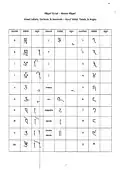Nāgarī script
The Nāgarī script or Northern Nagari[7] refers to a class of northern Indic scripts, from which specific standard styles of writing like Devanagari, Nandinagari and other variants evolved. It was first used to write Prakrit languages as well as Classical Sanskrit. The term is sometimes used as a shortened synonym for Devanagari script.[8][9] It came in vogue during the first millennium CE.[10]
| Nāgarī | |
|---|---|
 The word Nāgarī in the Nāgarī script. | |
| Script type | |
Time period | Early signs: 1st century CE, Developed form: 7th century CE |
| Languages | |
| Related scripts | |
Parent systems | |
Child systems | |
Sister systems | Bengali-Assamese script, Odia script,[2] Nepalese |
[a] The Semitic origin of the Brahmic scripts is not universally agreed upon. | |

| Brahmic scripts |
|---|
| The Brahmi script and its descendants |
The Nāgarī script has roots in the ancient Brahmi script family.[9] Some of the earliest epigraph evidence attesting to the developing Sanskrit Nāgarī script in ancient India is from the 1st to 4th century CE inscriptions discovered in Gujarat.[11] The Nāgarī script was in regular use by 7th century CE, and had fully evolved into Devanagari and Nandinagari scripts by about the end of first millennium of the common era.[8][12][13]
Etymology
Nagari comes from नगर (Nagara), which literally means city,[14] and referred to the writing system used by educated/literate ones, or the way of communicating by civilized people (as opposed to primitive logographic representations).
Origins
The Nāgarī script appeared in ancient India as a central-eastern variant of the Gupta script (whereas Śāradā was the western variety and Siddham was the far eastern variety). In turn it branched off into several scripts, such as Devanagari and Nandinagari.
Usage outside India
The 7th century Tibetan king Songtsen Gampo ordered that all foreign books be transcribed into the Tibetan language, and sent his ambassador Tonmi Sambota to India to acquire alphabetic and writing methods, who returned with a Sanskrit Nāgarī script from Kashmir corresponding to twenty-four (24) Tibetan sounds and innovating new symbols for six (6) local sounds.[15]
The museum in Mrauk-u (Mrohaung) in the Rakhine state of Myanmar held in 1972 two examples of Nāgarī script. Archaeologist Aung Thaw describes these inscriptions, associated with the Chandra, or Candra, dynasty that first hailed from the ancient Indian city of Vesáli:[16]
... epigraphs in mixed Sanskrit and Pali in North-eastern Nāgarī script of the 6th century dedicated by [Queen] Niti Candra and [King] Vira Candra
— Aung Thaw, Historical sites in Burma (1972)
 Coppern plates in Nāgarī script, 1035 CE
Coppern plates in Nāgarī script, 1035 CE Nagari Script 01
Nagari Script 01 Nagari Script 02
Nagari Script 02
References
- https://archive.org/details/epigraphyindianepigraphyrichardsalmonoup_908_D/mode/2up,p39-41
- Handbook of Literacy in Akshara Orthography, R. Malatesha Joshi, Catherine McBride(2019),p.27
- Daniels, P.T. (January 2008). "Writing systems of major and minor languages".
{{cite journal}}: Cite journal requires|journal=(help) - Masica, Colin (1993). The Indo-Aryan languages. p. 143.
- Richard Salomon (1992), Indian Epigraphy, Oxford University Press, p. 81
- D.R. Sahni (1911), Sahet-Mahet plate of Govinda Chandra Samvat 1186, Epigraphia Indica, Volume XI, pp. 20–26
- Tripathi, Kunjabihari (1962). The Evolution of Oriya Language and Script. Utkal University. p. 28. Retrieved 21 March 2021.
Northern Nāgarī (almost identical with modern Nagari)
- Kathleen Kuiper (2010), The Culture of India, New York: The Rosen Publishing Group, ISBN 978-1615301492, page 83
- George Cardona and Danesh Jain (2003), The Indo-Aryan Languages, Routledge, ISBN 978-0415772945, pages 68-69
- "Devanagari through the ages". India Central Hindi Directorate (Instituut voor Toegepaste Sociologie te Nijmegen). University of California. 1967.
{{cite book}}: CS1 maint: location missing publisher (link) - Gazetteer of the Bombay Presidency, p. 30, at Google Books, Rudradaman’s inscription from 1st through 4th century CE found in Gujarat, India, Stanford University Archives, pages 30-45
- Richard Salomon (2014), Indian Epigraphy, Oxford University Press, ISBN 978-0195356663, pages 33-47
- Pandey, Anshuman. (2017). Final proposal to encode Nandinagari in Unicode.
- Monier Williams Online Dictionary, nagara, Cologne Sanskrit Digital Lexicon, Germany
- William Woodville Rockhill, Annual Report of the Board of Regents of the Smithsonian Institution, p. 671, at Google Books, United States National Museum, page 671
- Aung Thaw (1972). Historical sites in Burma. Rangoon: Ministry of Union Culture, Government of the Union of Burma. OCLC 65722346.